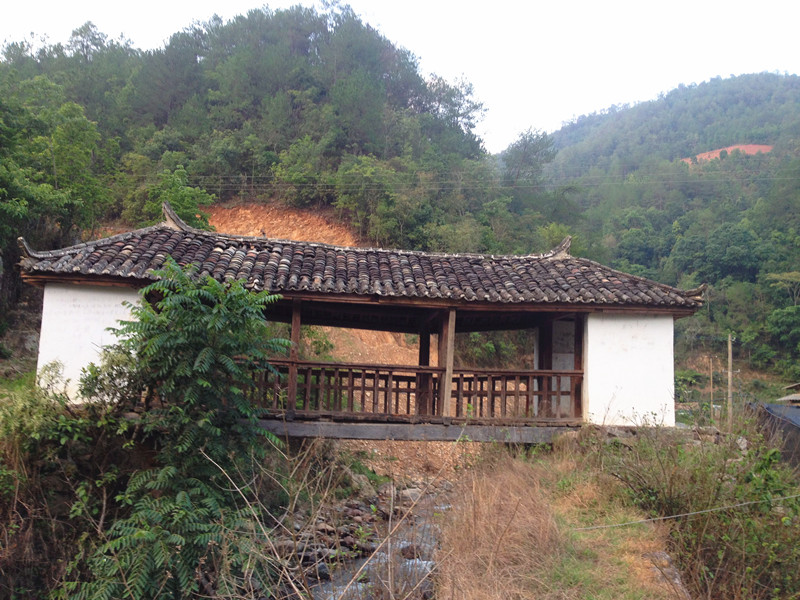Qiongfeng Bridge in Fengqing County, Lincang
Overview of Qiongfeng Bridge
Qiongfeng Bridge (琼凤桥), also known as Dongfeng Bridge (东风桥), is situated over the Shundian River (顺甸河) in Sanchahe Town (三岔河镇), Fengqing County (凤庆县), Lincang City (临沧市), Yunnan Province (云南省). This wooden corridor bridge connects the eastern and western sections of Sanchahe Town and was constructed in 1925 (the 14th year of the Republic of China) with funds donated by local residents. The bridge features a wooden structure complete with a bridge house, pavilions, and railings. Measuring 40 meters long and 3.5 meters wide, it holds the record as the longest wooden corridor bridge in the county. Until the 1970s and 1980s, it served as the main transportation route across the river and is still in use today. Qiongfeng Bridge is a significant milestone in local bridge architecture, showcasing unique artistic features and cultural value.
Historical Significance
Located in the southern part of Fengqing County, Sanchahe Town derives its name from the confluence of the Yalang River (雅琅河) and Lidi River (犁地河) into the Shundian River. The bridge, known locally as “Da Mu Qiao” (大木桥) or “Lover’s Bridge” (情人桥), symbolizes the villagers’ hopes for a better life. The entrance to the bridge features traditional Han Chinese architecture typical of the Republic of China, inscribed with the words “Dongfeng Bridge.” Although it has two names, locals still prefer to call it “Qiongfeng Bridge.”
The bridge is constructed entirely of wood, without nails or rivets, yet it has endured for over a century. Its design includes two main wooden beams extending from the pillars to the center of the river, supported by six layers of beams that create a stable structure. The upper part features a saddle-roof design, enhancing the bridge’s load-bearing capacity.
Architectural Features
The sides of the bridge are covered with rectangular wooden panels, serving both as awnings and railings. The bridge deck forms a gentle arch, with additional wooden planks laid to create a pathway for pack animals, distributing weight evenly for safe passage.
The bridge ends are topped with roofs made of wood, tiles, and bricks, applying pressure to secure the structure. The two-story roofs are elegantly designed, with a stable overhanging eave and finely crafted narrow eaves.
Inside the bridge, wooden benches provide rest spots for travelers. These benches, though simple and robust, show deep cracks from years of use, with some intentionally angled at 45 degrees for comfort. This detail reflects the builders’ careful consideration and craftsmanship.
The bridge integrates seamlessly with its surroundings, blending practical engineering with artistic expression. The seemingly rough wooden structure conceals the intricate craftsmanship of skilled artisans, ensuring stability and durability.
Cultural Heritage and Restoration Efforts
To preserve and promote local culture, Sanchahe Town emphasizes historical respect and conservation in its restoration efforts. The cultural significance of the bridge has been explored deeply, and public service functions have been expanded to revitalize this precious cultural heritage. In March 2017, Qiongfeng Bridge underwent restoration using traditional construction techniques, reinforcing the bridge with new materials while maintaining its historical integrity.
Location and Access
- Address: Sanchahe Town, Fengqing County, Lincang City, Yunnan Province, China (云南省临沧市凤庆县三岔河镇).
How to Get There
Visitors can reach Qiongfeng Bridge by:
- Car: Drive from Lincang City, following signs to Fengqing County and Sanchahe Town.
- Public Transport: Utilize local buses or taxis to Sanchahe Town and ask for directions to Qiongfeng Bridge.
Travel Tips
- Best Time to Visit: Spring and autumn provide pleasant weather and beautiful scenery.
- What to Bring: A camera for capturing the unique architecture and scenic views, and comfortable walking shoes for exploring the area.
- Local Cuisine: Don’t miss the opportunity to try local dishes at nearby eateries to enrich your cultural experience.


















